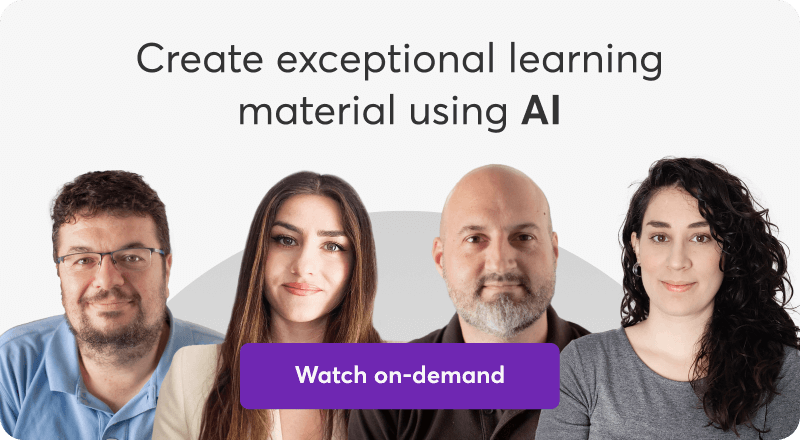Table of Contents
Everyone loves a compelling story. A story masterfully told evokes emotions, creates images, and makes us forget about time and space.
Have you thought that storytelling could help you create engaging, interesting, and authentic assessments? Assessments that are nothing like the monotonous video first/multiple-choice quiz next sequence your learners are accustomed to (and rather tired of).
But what makes for a good story? And how can you integrate storytelling into your assessments?
Our team of experts recently gave an informative, interactive webinar showing the 12 steps to create story-based assessments using the LearnWorlds platform.
LearnWorlds has superior capabilities you won’t find anywhere else that enable you to reimagine learner assessment and build it on the premises of storytelling, providing your learners with an experience they’ve never had before!
You can watch the full 1-hour webinar below or read the gist right in this post!
Table of contents
- Assessments & Storytelling: What You Need to Know
- 12 Steps to Create Story-Based Assessments
- 1Create the Scenery
- 2Tell a Story
- 3Design Authentic Questions
- 4Tell a Surprising Story
- 5Go Beyond the Ordinary
- 6Be a Real Part of the Story
- 7Warm Them up
- 8No Self-Reflection, No Learning
- 9Measure With Accuracy
- 10Safe Environment for Your Story
- 11Post-Submission Hyper-Personalization
- 12Depth of Expertise
How can storytelling empower your academy’s exams? How can you create an engaging story while proving that your training works?
Before we share the 12-step process for creating story-based assessments, let’s answer one fundamental question.
What does a story consist of?
Here at LearnWorlds, we believe that storytelling and assessments go hand in hand.
We believe in the multimodal and narrative nature of learning, so we support all the key features to design impactful and efficient assessments with the power of storytelling.
Next, let’s see the 12-step framework for creating story-based assessments that excite your learners while effectively measuring their progress!
Your entire course is a story. So think of yourself as a movie director! You’re the curator of an experience – a narrator presenting a story to your audience. Let’s see step by step how you can create story-based assessments with our platform.
1. Create the Scenery
One of the first things you must think of when creating a movie is the scenery. What is the background? What is the environment, the stage where this play will happen? The background colors, the navigation, and all the simple, actionable items your students will interact with set the scenery.
Our suggestion:
2. Tell a Story
To present the assessment as a story, you need two things:
Elements like text, video, and widgets, will help you present the story. LearnWorlds allows you to add these elements, so you can present your narration.
Usually, we just start with the first question without even introducing ourselves. That’s the wrong practice because students have come to the assessment to “discuss” with us (since we’ll ask things, and they’ll answer back). Instead of diving right in with a question, try doing the following:
3. Design Authentic Questions
Stories are about senses, so you should involve hearing and watching and not stop at text-based assessments. This is a serious limitation that still exists in many LMSs, but not in LearnWorlds.
No matter which type of assessment you’re using (multiple-choice, true-false, etc.), you can add any widget you like. So think creatively! Make multimodal assessments by combining multiple-choice with video and images, YouTube videos, or any other means of multimodal assessment.
💡 Instead of writing a question, create a brief video asking it. This imitates a live oral exam between you and your students and creates a more engaging experience that doesn’t feel premade. It shows that you’ve put personal attention and care and enables you to make a connection with your learners.
4. Tell a Surprising Story
To keep the story interesting and maintain learners’ focus and make them excited about the next step…
Variety creates a more meaningful interaction while keeping learners on their toes. You should also keep in mind the accessibility factor – cognitive and physical disabilities might hinder your learners from submitting the typical written assignments or answering multiple-choice questions.
✨ Supercharge Your Course Creation with AI!
Want to create exceptional learning experiences faster and smarter? Discover how you can harness the power of AI in instructional design. Watch our on-demand webinar to learn tips, tricks, and best practices from industry experts.
5. Go Beyond the Ordinary
Feedback is usually very straightforward and starts with the results/submission screen. Once the student lands there, you need to persuade them about their achievements, encourage them to do more things, etc.
Most creators just set up an automated system, and the feedback appears once the learners submit their answers. This is not the case in LearnWorlds, because:
a) Our platform gives you control to customize the ending screen. You can choose among a:
b) It’s up to you to decide how much feedback you want to give. LearnWorlds allows you to give manual feedback to everything, both for right and wrong answers, and combine automated with manual feedback if you wish to. Now, that’s a nice plot twist, right?
6. Be a Real Part of the Story
Video-based assessments and feedback help both parties become more active participants in the story. Let’s see the benefits of using video in each case:
Benefits of video-based feedback
Benefits of video-based learning assessments
7. Warm Them up
It’s nice to add variety to our assessments and not repeat the same pattern. And remember to allow learners to self-assess and measure their progress by themselves. This will also give you the chance to help them through feedback.
8. No Self-Reflection, No Learning
Stories are about provoking thoughts and triggering metacognitive processes. There are several moments throughout your course where you need your learners to test their understanding and critical thinking through self-assessment and learning diaries.
A self-assessment is a kind of “silence” in the middle of the story because you ask learners to distance themselves from what’s being said and interact with themselves. Remember that self-assessments should be non-graded. They’re the learner’s space to share their thoughts.
9. Measure With Accuracy
In the past, grading and evaluating were more “black and white,” with only right or wrong answers. Now, you can evaluate learner progress more flexibly by doing the following:
10. Safe Environment for Your Story
One of the worst things that may happen during an exam, i.e., a narrative experience, is a technical failure like a page crushing or a lost internet connection. This will make your learners go back and relive the same narrative again.
Having to rewatch the story will make it feel inauthentic and bore learners – if they bother to return back to it at all. LearnWorlds prevents these issues with server-side measurement and auto-recovery for fewer frustrations.
11. Post-Submission Hyper-Personalization
There’s one more thing you can do besides offering feedback – adding tags to learners based on their answers. A tagging system will help you categorize learners and automate the next steps, like special offerings.
12. Depth of Expertise
Your story must have a happy ending to leave learners on a positive note and keep them motivated. This happy ending, the last part of a story, is a certificate.
Certificates signify the moment of completion. Therefore, they should be professional and underline the effort of the student to reach that point – the last scene of the story.
💡 Remember to customize with your brand to build trust & credibility.
The narrative theory inspires us to create engaging stories that transform how we interact with our learners throughout our online course.
In LearnWorlds, we say that assessment is a story – and so are the course and the learning path you’ve built for your learners. LearnWorlds is THE platform for creative narrative learning experiences, supporting the creation of interactive, customizable, and fully personalized assessments.
Watch the webinar below to dive deeper into the presentation and see how to use relevant features.
Not a customer yet? Try LearnWorlds with a 30-day free trial – no credit card, no commitment, and most features available for the full LearnWorlds experience!

Androniki Koumadoraki
Androniki is a Content Writer at LearnWorlds sharing Instructional Design and marketing tips. With solid experience in B2B writing and technical translation, she is passionate about learning and spreading knowledge. She is also an aspiring yogi, a book nerd, and a talented transponster.


